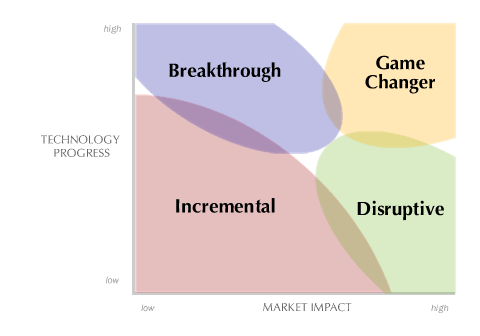Does responsible innovation require radical innovation and does this raise new moral issues? This question was raised by professor Ibo van der Poel in his lecture on incremental and radical innovations. In his lecture he considered various new types of innovation; product vs. process innovation, radical, incremental, niche, revolutionary, and architectural. By analysing these types he aimed at explaining the necessity for radical changes in the search for responsible innovation. With these various techniques I took a look at society today and found out in which size, business type and/or products these types of innovations fit.
To start off I believe it to be important to clarify the various blocks. All of which comes down to the taxonomy developed by Abernathy and Clark in 1985; two axes, existing knowledge versus new knowledge and new markets versus existing markets. Dividing new innovations in separate blocks according to these different axes, allows a pattern to establish itself and regulate new innovations. Incremental and architectural innovations being each other’s exact opposite show the real need for radical innovations to take place. These are considered innovations that apply new operational principles, new scientific knowledge, can offer new functionalities, reach out to new user groups, or may serve new types of values.
First I would like to analyse incremental innovations as these are the most stable innovations that take place in society. They are based on existing knowledge and aimed at existing customers, such as in large mobile phone companies where engineers improve their older creations on quite a frequent base. These larger businesses prefer incremental over radical innovations because it is a more stable form of innovation, in which the ‘everything or nothing’ mentality does not apply. Instead of using completely new technologies they base their techniques on existing knowledge, meaning less risk for the company. In a time of economic debt stability is a popular belief, especially in such a competitive market.
Next is the niche innovation, one that follows the footsteps of incremental by building on existing knowledge to create new innovations. However it does aim to reach out to new customers or new markets using that same technology. Niches provide the seeds of change within a systems innovation, as we can see with the existing technology of the GPS, primarily used during wars and later on implemented in regular use for cars and even cycling nowadays. Both small and larger businesses make use of this type of innovation. Larger corporations such as TomTom might have only noticed the various uses of their creation after they had fully developed their gps for cars.
These relatively stable innovations are eventually exceeded by one type; radical innovation. These are pushed by the ‘everything or nothing’ mentality of new enterprises that want to make a name for themselves, instead of the safe methods of larger corporations who have an existing brand name to uphold. The speed of small businesses, with smaller boards of advisors, less rules and protocol and fresh minds, definitely allow them to revolutionize markets with society-changing radical innovations.
